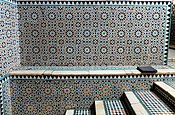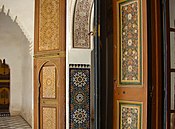A | B | C | D | E | F | G | H | CH | I | J | K | L | M | N | O | P | Q | R | S | T | U | V | W | X | Y | Z | 0 | 1 | 2 | 3 | 4 | 5 | 6 | 7 | 8 | 9
| Part of a series on |
| Arabic culture |
|---|
 |
Islamic geometric patterns are one of the major forms of Islamic ornament, which tends to avoid using figurative images, as it is forbidden to create a representation of an important Islamic figure according to many holy scriptures.
The geometric designs in Islamic art are often built on combinations of repeated squares and circles, which may be overlapped and interlaced, as can arabesques (with which they are often combined), to form intricate and complex patterns, including a wide variety of tessellations. These may constitute the entire decoration, may form a framework for floral or calligraphic embellishments, or may retreat into the background around other motifs. The complexity and variety of patterns used evolved from simple stars and lozenges in the ninth century, through a variety of 6- to 13-point patterns by the 13th century, and finally to include also 14- and 16-point stars in the sixteenth century.
Geometric patterns occur in a variety of forms in Islamic art and architecture. These include kilim carpets, Persian girih and Moroccan zellij tilework, muqarnas decorative vaulting, jali pierced stone screens, ceramics, leather, stained glass, woodwork, and metalwork.
Interest in Islamic geometric patterns is increasing in the West, both among craftsmen and artists like M. C. Escher in the twentieth century, and among mathematicians and physicists such as Peter J. Lu and Paul Steinhardt.
Background
Islamic decoration
Islamic geometric patterns are derived from simpler designs used in earlier cultures: Greek, Roman, and Sasanian. They are one of three forms of Islamic decoration, the others being the arabesque based on curving and branching plant forms, and Islamic calligraphy; all three are frequently used together.[1][2] From the 9th century onward, a range of sophisticated geometric patterns based on polygonal tessellation began to appear in Islamic art, eventually becoming dominant.[3]
Islamic art mostly avoids figurative images to avoid becoming objects of worship.[4][5] This aniconism in Islamic culture caused artists to explore non-figural art, and created a general aesthetic shift toward mathematically based decoration.[6]
Purpose
Authors such as Keith Critchlow[a] argue that Islamic patterns are created to lead the viewer to an understanding of the underlying reality, rather than being mere decoration, as writers interested only in pattern sometimes imply.[7][8] In Islamic culture, the patterns are believed to be the bridge to the spiritual realm, the instrument to purify the mind and the soul.[9] David Wade[b] states that "Much of the art of Islam, whether in architecture, ceramics, textiles or books, is the art of decoration – which is to say, of transformation."[10] Wade argues that the aim is to transfigure, turning mosques "into lightness and pattern", while "the decorated pages of a Qur’an can become windows onto the infinite."[10] Against this, Doris Behrens-Abouseif[c] states in her book Beauty in Arabic Culture that a "major difference" between the philosophical thinking of Medieval Europe and the Islamic world is exactly that the concepts of the good and the beautiful are separated in Arabic culture. She argues that beauty, whether in poetry or in the visual arts, was enjoyed "for its own sake, without commitment to religious or moral criteria".[11]
- Styles of Islamic geometric decoration
-
Tiles inside the Jame Mosque of Yazd, Persia, with geometric and vegetal patterns
-
Zdroj:https://en.wikipedia.org?pojem=Islamic_geometric_patterns
>Text je dostupný pod licencí Creative Commons Uveďte autora – Zachovejte licenci, případně za dalších podmínek. Podrobnosti naleznete na stránce Podmínky užití.
Text je dostupný za podmienok Creative
Commons Attribution/Share-Alike License 3.0 Unported; prípadne za ďalších
podmienok.
Podrobnejšie informácie nájdete na stránke Podmienky
použitia.






